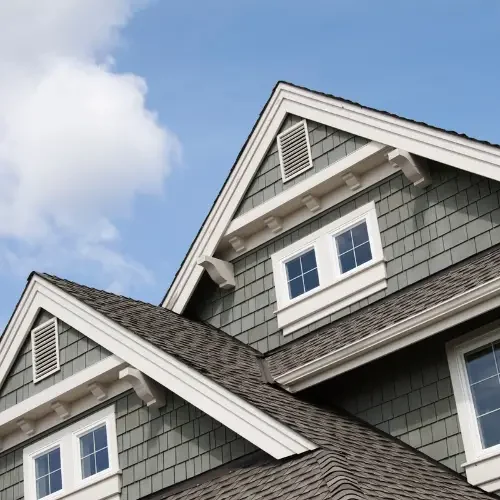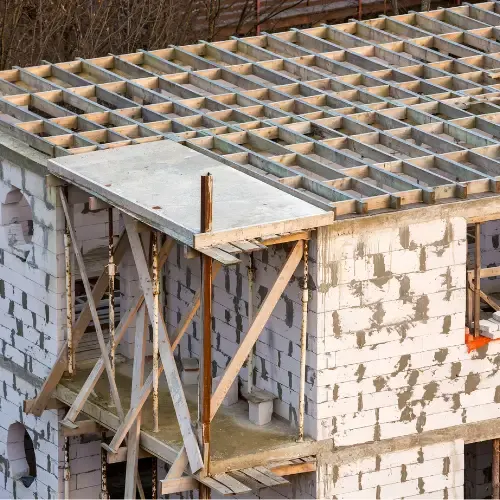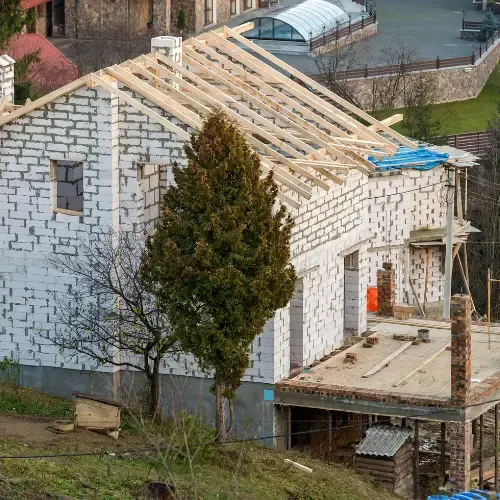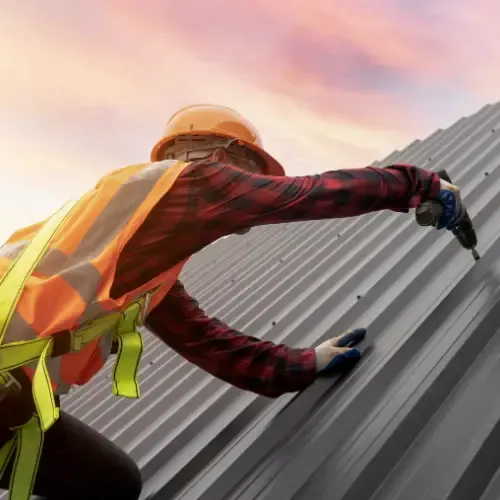
Understanding the various parts of your roof is a crucial aspect of responsible homeownership. In fact, we’d go so far as to say, that a big part of owning a home is having an understanding of how your roofing works, and here is why:
Maintenance and Care: Knowing the components of your roof helps identify and address potential issues early, thus preventing costly damage. Regular inspection of key elements like flashing, shingles, and gutters can extend your roof’s lifespan.
Weather Preparedness: Being aware of your roof’s anatomy allows you to prepare for weather-related challenges. You’ll know how to safeguard against leaks, ice dams, and storm damage, ensuring your home remains safe and dry.
Repair and Replacement: When repairs or replacements are necessary, understanding your roof simplifies the process. You can communicate effectively with contractors, make informed decisions, and ensure the work meets your expectations.
Energy Efficiency: Some roof components, like ventilation systems, play a vital role in your home’s energy efficiency. Understanding these elements can help you optimize your heating and cooling costs.
Safety: Familiarity with your roof aids in safety. Knowing how to access and navigate your roof for cleaning or maintenance reduces the risk of accidents.
In this article, we delve deeper into the topic so that you gain a better understanding of your roof’s components. We provide valuable insights and practical tips to empower you as a homeowner. Knowledge is your best tool so it is worth taking the initiative to learn more about your roofing system.
Roof decking AKA Sheating
Roof decking is the layer of material that sits on top of the structural trusses or rafters of your roof. It serves as the foundation for your roofing system, providing a flat and sturdy surface onto which the roofing materials are attached. It’s typically made of plywood or oriented strand board (OSB) and comes in various thicknesses to accommodate different roofing materials and climate conditions.
Why Roof Decking Matters
- Support: Roof decking provides crucial support for all roofing materials, such as shingles, tiles, or metal panels. Without a solid decking, the roof could sag or develop dips, which can lead to water pooling and leaks.
- Durability: A well-installed roof deck enhances the overall durability of your roof. It helps distribute the weight of heavy snow loads ensuring the roof can withstand strong winds and other weather elements.
- Insulation: Roof sheathing also plays a role in insulation. It can help regulate the temperature in the attic, preventing excessive heat buildup in the summer and retain warmth in the winter.
Types of Roof Decking
Plywood and OSB are two common types of roof decking materials. Plywood is known for its strength and resistance to moisture, making it an excellent choice for areas with high humidity. OSB, on the other hand, is more cost-effective and thus widely used.
Both options have their pros and cons, so it’s essential to choose the one that best suits your needs and budget.
Maintaining Your Roof Decking
Proper maintenance of the home’s roof decking is essential for its long-term integrity. Regularly inspect your attic for signs of water damage, such as discoloration or sagging. If you spot any issues, address them promptly to prevent further damage to the decking and roofing materials.

Drip Edge
Imagine a protective shield for the edge of your roof – that’s your drip edge. It’s typically made of metal, like aluminum, and it’s installed along the eaves and rakes (the edges of your roof). The primary job of a drip edge is to manage water runoff. It helps direct rainwater away from your fascia, soffit, and siding, preventing water damage and rot.
Why Is It Important?
Here’s the deal – without a drip edge, water can sneak its way under your roofing materials, causing all sorts of trouble. It can damage the roof deck, lead to leaks, and even compromise your home’s structural integrity. Plus, it can create the perfect environment for mold and rot to thrive.
Proper Installation Matters
Now, it’s not just about having a drip edge; it’s about installing it correctly and thus you need to hire a roofing contractor for the job. An improperly installed drip edge won’t do its job effectively. It should be positioned slightly above the roof deck and extend over the edge. This way, water drips away from the fascia, not underneath it.
DIY or Professional Installation?
Installing a drip edge might sound like a simple job, but getting it just right requires skill and experience. If it’s not done correctly, you could end up with more problems which could lead to needing a roof replacement. So, it’s usually best to leave this task to the professionals.

Ice and Water Shield
Alright, let’s talk about an unsung hero of any roofing system – the ice and water shield. It might not be something you think about every day, but when it comes to protecting your home from the elements, this shield packs a punch.
What is an Ice and Water Shield?
Think of it as your roof’s secret weapon against ice dams and water infiltration. It’s a self-adhering membrane typically made of rubberized asphalt. It needs to be installed it in areas prone to ice buildup, like along the eaves, valleys, and around roof penetrations.
Why Does It Matter?
Ice dams – those icicles that hang from your roof – might look pretty, but they can cause major trouble. When snow melts and refreezes at the roof’s edge, it can back up under the shingles, leading to leaks and water damage. That’s where the ice and water shield comes in. It creates a watertight barrier that prevents that sneaky water from getting inside.
Proper Installation is Key
Installing an ice and water shield isn’t a DIY job. It requires expertise to ensure it’s applied correctly. It should extend at least two feet inside your heated living space to ensure maximum protection. When done right, it’s the home’s best defense against winter’s icy grip.

Roof Underlayment
The underlayment is a crucial element of the roofing system that often goes unnoticed. You might not see it once the shingles are in place, but it plays a vital role in protecting your home from moisture and providing an additional layer of defense against the elements. It is regardless of if the roof slope downward or if you have a gable roof, you still need it to protect the roof structure from damage.
What is Roof Underlayment?
Think of it as your roof’s second line of defense. Roof underlayment is a material installed directly on the roof deck, underneath your roofing material (shingles, tiles, or metal panels). It acts as a barrier that helps prevent water infiltration, protects against ice dams, and enhances the overall durability of your roof.
Why It Matters
Imagine a heavy rainstorm hits, and your roofing material gets damaged or lifted by strong winds. Without roof underlayment, water can quickly penetrate the roof deck springing leaks, leading to interior damage to the home. But with proper underlayment, your home remains protected until those roofing repairs can be made.
Types of Roof Underlayment
There are different types of roof underlayment, but the two most common ones are felt paper (asphalt-saturated felt) and synthetic underlayment. Felt paper has been around for a long time and provides good protection. Synthetic underlayment, on the other hand, is more modern and offers excellent resistance to moisture and UV rays.
Installation Tips
The key to a successful roof underlayment is proper installation similar to the roof’s decking. It should be smooth, free of wrinkles, and securely fastened to the roof deck. Overlapping seams correctly is crucial to ensure water doesn’t find its way through.
Starter Shingles
Starter shingles are the unsung heroes of many roofing systems. They’re the first layer of shingles installed at the eaves of your roof, right along the roof edge. You might not see them from the ground, but they serve a crucial purpose.
Why Do They Matter?
Think of starter shingles as the protective barrier for your roof. They’re designed to prevent wind-driven rain from getting under your shingles and causing leaks. Not having them means, you could be dealing with water damage and costly repairs down the road.
Proper Installation is Key
Ensuring that starter shingles are correctly installed is essential. They should overhang the edge of the roof slightly and be aligned perfectly to create a seamless seal. This prevents water infiltration and makes your roof look more aesthetically pleasing.
Roofing Materials
Choosing the right roofing material for your home is a significant decision since it can impact your home’s aesthetics, energy efficiency, and even its resale value. Here are some common roofing materials to help you make an informed choice.
Asphalt Shingles: Asphalt shingles are one of the most popular roofing materials. They are cost-effective, durable, and come in a variety of styles and colors. Asphalt shingles are a great choice for most homes and climates.
Metal Roofing: Metal roofing has gained popularity due to its longevity and energy efficiency. It can mimic the appearance of other materials like wood or tile while offering superior durability and low maintenance.
Wood Shingles or Shakes: If you want a rustic, natural look, wood shingles or shakes might be the way to go. Cedar and redwood are common choices. Keep in mind that wood roofing requires regular maintenance to prevent rot and pests.
Tile Roofing: Tile roofing, often seen in Mediterranean-style homes, adds a touch of elegance. Clay or concrete tiles are known for their longevity and resistance to fire and pests.
Slate Roofing: Slate roofing is renowned for its beauty and longevity. It can last for a century or more with proper care. However, it is one of the most expensive roofing options.
Synthetic Roofing: If you desire the look of natural materials without the high cost, synthetic roofing materials like synthetic slate or cedar shakes are worth considering.
Each roofing material has its advantages and disadvantages, so it’s crucial to assess your budget, climate, and aesthetic preferences before making a decision. Consult with a roofer to determine the best material for your home’s specific needs.
Roof Flashing
Roof flashing is a thin, weather-resistant material typically made from metal, such as aluminum or galvanized steel. The purpose of the metal flashing installed is to redirect water away from vulnerable areas of your roof where leaks are prone to occur, like valleys, chimneys, skylights, and roof edges.
Why Is Roof Flashing Important?
Imagine rain pouring down your roof during a storm. If you don’t have the proper flashing installed, water can seep into the nooks and crannies of your roof, causing leaks and water damage. Flashing acts as a barrier, ensuring that water is directed away from these vulnerable areas, keeping your home dry and free from potential structural damage.
Common Types of Roof Flashing:
1. Step Flashing: Used where the roof meets a vertical surface like a chimney or dormer. It’s installed in a step-like fashion to create a watertight seal.
2. Valley Flashing: Placed in roof valleys where two roof slopes meet, preventing water from pooling and causing leaks.
3. Drip Edge Flashing: Installed along the roof’s edges, guiding water into gutters and away from your home’s foundation.
4. Chimney Flashing: Surrounds the base of the chimney to prevent water from infiltrating this vulnerable area.
Remember that proper installation is key to the effectiveness of roof flashing. If it’s not correctly installed or if it is damaged over time, that will compromise the roof’s integrity.
Ridge Capping
Ridge capping is the protective covering that goes along the peak of your roof where two sloping sides meet. It’s like the crown on your roof, and it’s typically made of the same material as your roofing shingles, whether that’s asphalt, metal, or another material. Experienced roofing contractors always check to make sure that the capping is installed correctly or isn’t damaged.
Why Is Ridge Capping Important?
Now, here’s the crucial part. Ridge capping isn’t just there for aesthetics; it plays a vital role in keeping your roof watertight. Think of it as the ultimate barrier against the elements. Without proper ridge capping, rain, snow, and wind can sneak into the vulnerable ridge area, causing leaks and damage over time.
Proper Installation Matters
It’s not just about having ridge capping; it’s about having it installed correctly. Improper installation can lead to gaps or weak points that allow water to infiltrate. That’s why it’s essential to hire an experienced roofing professional who knows the ins and outs of ridge capping.
Regular Inspection and Maintenance
To ensure your ridge capping continues to do its job effectively, regular inspections are a must. Over time, the elements along with wear and tear can cause it to deteriorate. If you notice any cracks, gaps, or loose ridge capping, it’s time to address them promptly to prevent potential issues.
Roof Vents
Imagine your attic on a hot summer day. The sun is beating down on your roof, and the temperature inside the attic is soaring. Now without proper ventilation, this heat can get trapped, turning your attic into an oven. This not only makes your home less comfortable but can also lead to problems like premature shingle aging and energy inefficiency.
The Cooling Effect
Roof vents act as the exhaust system for your attic. They allow hot, stagnant air to escape and draw in cooler, fresher air from outside. This natural airflow helps regulate the temperature in your attic, preventing it from becoming excessively hot. In colder months, it also helps reduce moisture buildup that can lead to mold and rot.
Types of Roof Vents
There are various types of roof vents, including ridge vents, box vents, and turbine vents. Each serves a specific purpose, and the choice depends on your roofing design and needs. For example, ridge vents are installed along the peak of your roof, providing a continuous exhaust point, while box vents are more discreet and can be strategically placed.
Maintenance Matters
Roof vents are not exactly set-and-forget components as some people assume. Regular maintenance is essential to ensure they function correctly. You should inspect them for blockages by debris or even critters seeking shelter.
Roof Facets
Roof facets, also known as roof slopes or roof pitches, are a crucial aspect of your roofing system and that’s regardless of the roofing style. They determine the angle or steepness of your roof, and understanding them is vital for various reasons.
Why Roof Facets Matter
The pitch of your roof affects its appearance, performance, and maintenance requirements. For instance, a steeply pitched roof may shed snow and rain more effectively, while a flatter roof might offer additional living or storage space.
Types of Roof Facets
Roof facets can vary from nearly flat to very steep, and they are typically described in terms of a ratio like 4:12 or 8:12. The first number represents the vertical rise, while the second number represents the horizontal run. For example, a 4:12 pitch means the roof rises 4 inches vertically for every 12 inches of horizontal run.
Practical Considerations
The pitch of your roof affects material choices and installation methods. For instance, shingles and tiles are commonly used on roofs with pitches of 4:12 or greater, while low-pitched or flat roofs may require different materials like modified bitumen or TPO.
Maintenance Matters
The pitch also plays a role in roof maintenance. Steep roofs are generally easier to walk on for inspections and repairs, while low-pitched roofs may require specialized equipment and extra caution.
Conclusion
Understanding the various parts of your roof is paramount for any homeowner. Your roof is not just a single entity but a complex system comprised of different components, each with its unique role and importance.
By familiarizing yourself with these roofing components, you become a more informed homeowner. You’ll be better equipped to identify potential issues, communicate effectively with roofing professionals, and make informed decisions when it comes to roof repairs or replacements.
Remember that your roof is the home’s first line of defense against weather, and taking care of it is an investment in your property’s longevity and your family’s safety and comfort. So, take the time to learn about your roof, perform regular inspections, and address any concerns promptly. Your diligence will pay off in the long run, ensuring your roof continues to protect your home for years to come.
FAQs
Q. What is the parts of a roof?
A. The parts of a roof include the roof deck, underlayment, roofing material, flashing, roof ventilation, ridge, eaves, valleys, gutters and downspouts, chimney, skylights, and dormers, depending on the roof’s design and purpose.
Q. What are the 4 parts of a roof?
A. While the components of a roof can vary, the four fundamental parts of a roof are the roof deck, underlayment, roofing material, and flashing.
Q. What are the pieces of a roof called?
A. The individual components of a roof are collectively referred to as the “roofing system” or “roof assembly.”

